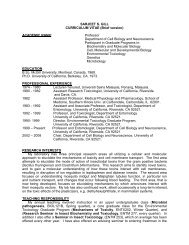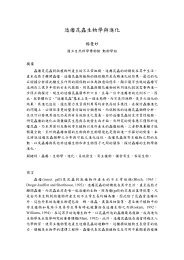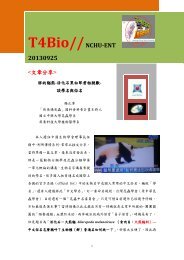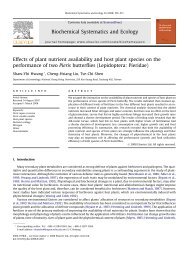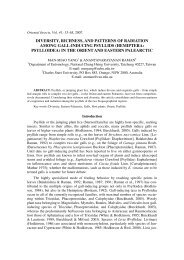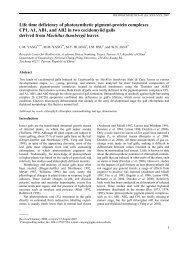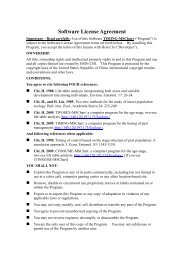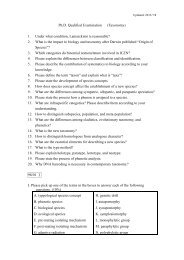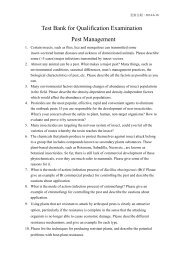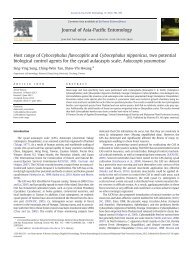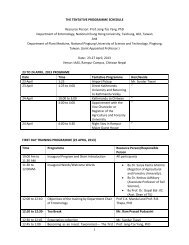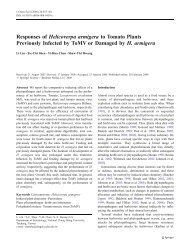Chi, H., and H. Liu. 1985. Two new methods for the study of insect ...
Chi, H., and H. Liu. 1985. Two new methods for the study of insect ...
Chi, H., and H. Liu. 1985. Two new methods for the study of insect ...
You also want an ePaper? Increase the reach of your titles
YUMPU automatically turns print PDFs into web optimized ePapers that Google loves.
INSECT POPULATION ECOLOGY 227<br />
Fig. 2. The age-stage-specific growth rate matrix (G), developmental rate matrix<br />
(D) <strong>and</strong> fecundity matrix (F). In matrix G, g i j is <strong>the</strong> probability that an<br />
individual from ( i, j ) will grow to ( i1, j ) after one age interval. In matrix<br />
D, d i j is <strong>the</strong> probability that an individual from ( i, j) will develop to ( i1,<br />
j1 ) after one age interval; in column PM, d i j is <strong>the</strong> probability that an<br />
individual from ( i, j1 ) will develop to ( i1, j1 ) ( from pupa to male ).<br />
In matrix F, f i j is <strong>the</strong> number <strong>of</strong> <strong>of</strong>fsprings that will be reproduced by<br />
every individual in age i <strong>and</strong> stage j.<br />
In matrix G, <strong>the</strong> element g ij (<strong>the</strong> age-stagespecific<br />
growth rate) is <strong>the</strong> probability that<br />
an individual in age i <strong>and</strong> stage j will grow<br />
to age i1 but still be in stage j after one<br />
age interval. In matrix D, d ij (<strong>the</strong> age-stagespecific<br />
developmental rate) is <strong>the</strong> probability<br />
that an individual in age i <strong>and</strong> stage j will<br />
develop to stage j1 <strong>and</strong> be in age i1 after<br />
one age interval. Because female <strong>and</strong> male<br />
will not develop to fur<strong>the</strong>r stages, <strong>the</strong>re are<br />
no d ij <strong>for</strong> <strong>the</strong>m. But <strong>the</strong> pupae can ei<strong>the</strong>r<br />
develop into a female or male. We set <strong>the</strong><br />
probability that a pupa will develop into a<br />
female in column PF <strong>and</strong> <strong>the</strong> probability <strong>for</strong><br />
a male in column PM, thus <strong>the</strong> column m— 1<br />
(PM) contains <strong>the</strong> values <strong>for</strong> pupa to male,<br />
i. e. from n i(m-2) to n (i+1)m (Fig. 2). In matrix,<br />
F, f i j (<strong>the</strong> age-stage-specific fecundity) are <strong>the</strong><br />
number <strong>of</strong> <strong>of</strong>fsprings that will be reproduced<br />
by every individual <strong>of</strong> n ij. In general, only<br />
female have a f i j 0, <strong>and</strong> <strong>the</strong> o<strong>the</strong>r f i j have<br />
<strong>the</strong> value zero. All elements <strong>of</strong> <strong>the</strong>se three<br />
matrices (G, D <strong>and</strong> F) can be obtained in <strong>the</strong><br />
basic life table <strong>study</strong>.<br />
(3) Population growth<br />
When <strong>the</strong> age-stage-structure <strong>of</strong> a population<br />
at time t is known, <strong>the</strong> age-stagestructure<br />
<strong>for</strong> time t+1 can be obtained through<br />
<strong>the</strong> combined operation <strong>of</strong> G , D <strong>and</strong> F:<br />
G, D, F<br />
N t N t+1<br />
The detail calculation procedures are:<br />
k m<br />
n 11 ( t + 1 ) ( ∑ ∑ n i j t f i j )<br />
i = 1 j = 1<br />
n i j ( t + 1 ) n ( i – 1 ) j t g ( i – 1 ) j<br />
<strong>for</strong> j 1 <strong>and</strong> i 1,<br />
n i j ( t + 1 ) n ( i -1 ) j t g ( i – 1 ) j <br />
n ( i - 1) ( j – 1 ) t d ( i – 1 ) ( j – 1 )<br />
<strong>for</strong> 1jm,<br />
n i j ( t + 1 ) n ( i – 1 ) j t g ( i – 1 ) j<br />
n ( i – 1 ) ( j – 2 ) t d ( i – 1 ) ( j – 1 )<br />
<strong>for</strong> jm ( <strong>the</strong> male ).<br />
We need only sum <strong>the</strong> elements in each<br />
row to get <strong>the</strong> age-structure, <strong>and</strong> sum <strong>the</strong>



